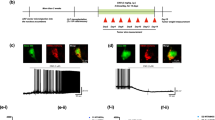Abstract
Studies reported here demonstrated that activation of the dopaminergic system induces increases in the immune response regardless of the type of behavior in mice (line CBA), i.e., in aggressive mice, submissive mice, and mice lacking experience of victory or defeat (controls). Changes in the activity of the dopaminergic system were induced with SKF-38393, a selective agonist of dopamine D1 receptors, and with p-chlorophenylalanine (PCPA), which we have previously shown to activate D2 receptors. In the aggressive form of behavior, which was characterized by strong (compared with controls) immune responses, SKF-38393 and PCPA led to further increases in the immune response. In submissive mice, activation of the dopaminergic system altered the nature of the immune response, with immunostimulation, as in aggression. It is suggested that activation of the dopaminergic system in conditions of defined psychoemotional status fixed by acquisition of opposite types of behavior, induces the formation of a new neurochemical pattern – the dopaminergic set – which led to changes in the nature and intensity of the immune response.
Similar content being viewed by others
REFERENCES
L. V. Devoino, E. L. Al'perina, E. K. Podgornaya, O. V. Polyakov, G. V. Idova, and R. Yu. Il'yuchenok, “Involvement of dopaminergic systems in the functional specialization of brain areas during the formation of aggressive and submissive behavior in mice,” Zh. Vyssh. Nerv. Deyat., 51,No. 2, 197–205 (2001).
L. V. Devoino, E. L. Al'perina, E. K. Podgornaya, O. V. Polyakov, G. V. Idova, and R. Yu. Il'yuchenok, “Characteristics of the distribution of serotonin and its metabolites in brain structures and the development of immunosuppression in submissive mice,” Ros. Fiziol. Zh. im. I. M. Sechenova, 88,No. 1, 106–112 (2002).
L. V. Devoino, G. V. Idova, E. L. Al'perina, and M. A. Cheido, “Neurochemical systems of the brain — the extraimmune mechanism of psychoneuroimmunomodulation,” Vestn. Ros. Akad. Med. Nauk., 9, 19–24 (1998).
L. V. Devoino, and R. Yu. Il'yuchenok, Neurotransmitter Systems in Psychoneuroimmunomodulation: Dopamine, Serotonin, GABA, Neuropeptides [in Russian], TsÉRIS, Novosibirsk (1993), p. 237.
G. V. Idova, M. A. Cheido, and L. V. Devoino, “IgM-and IgG-rosette formation in the primary and secondary immune responses in a system consisting of syngeneic transfer of spleen cells,” Zh. Mikrobiol., 2, 57–60 (1978).
N. N. Kudryavtseva and I. V. Bakshtanovskaya, “Neurochemical control of aggression and submission,” Zh. Vyssh. Nerv. Deyat., 40,No. 3, 459–466 (1991).
G. N. Kryzhanovskii, S. V. Magaeva, and S. V. Makarov, Neuroimmunopathology [in Russian], Moscow (1997).
S. Basu and P. S. Dasgupta, “Dopamine, a neurotransmitter, influences the immune system,” J. Neuroimmunol., 102,No. 2, 113–124 (2000).
D. C. Blanchard, P. Chollvanich, R. J. Blanchard, D. W. Chow, R. P. Hammer, J. K. Rowlett, and M. T. Bardo, “Serotonin, but not dopamine, metabolites are increased in selected brain regions of subordinate male rats in a colony environment,” Brain Res., 568, 61–66 (1991).
A. J. Cunningham, “A method of increased sensitivity for detecting single antibody-forming cells,” Nature, 207, 1106–1107 (1965).
L. Devoino, E. Alperina, N. Kudryavtseva, and N. Popova, “Immune responses in male mice with aggressive and submissive behaviour patterns: strain differences,” Brain Behav. Immun., 7, 91–96 (1993).
L. Devoino, G. Idova, E. Alperina, and M. Cheido, “Brain neuromediator systems in the immune response control: pharmacological analysis of pre-and postsynaptic mechanisms,” Brain Res., 633, 267–274 (1994).
R. Hitzemann, K. Dains, C. Bier-Langing, and N. R. Zahniser, “On the selection of mice for haloperidol response and non-response,” Psychopharmacol., 103, 244–250 (1991).
G. Idova, M. Cheido, and L. Devoino, “Modulation of the immune response by changing neuromediators systems activity under stress,” Int. J. Immunopharmacol., 19,No. 9–10, 535–540 (1997).
K. A. Miczek, J. F. DeBold, and A. M. M. van Erp, “Neuropharmacological characteristics of individual differences in alcohol effects on aggression in rodents and primates,” 5, 407–421 (1994).
E. M. Nikulina and N. S. Kapralova, “Role of dopamine receptors in the regulation of aggression in mice: relationship of genotype,” Neurosci. Behav. Physiol., 22,No. 5, 364–369 (1992).
G. Nistico, M. C. Caroleo, M. Arbitrio, and L. Pulvirenti, “Dopamine D1-receptors in the amygdala enhance the immune response in the rat,” Ann. N.Y. Acad. Sci., 741, 316–323 (1994).
G. Nistico, M. C. Caroleo, M. Arbitrio, and L. Pulvirenti, “Evidence for an involvement of dopamine D1-receptors in the limbic system in the control of immune mechanisms,” Neuroimmunomodulation, 1,No. 3, 174–180 (1994).
J. M. Petitto, J. L. Gariepy, P. L. Gendreau, M. H. Lewis, and D. T. Lysle, “Differences in NK cell function in mice bred for high and low aggression: genetic linkage between complex behavioral and immunological traits?” Brain Behav. Immun., 13,No. 2, 175–186 (1999).
F. Richard, J. L. Sanne, O. Bourde, D. Weissman, M. Ehret, C. Cash, M. Maitre, and J. F. Pujol, “Variation of tryptophan-5-hydrolase concentrations in the rat raphe dorsalis nucleus after p-chlorophenylalanine administration. 1. A model to study the turnover of the enzymatic protein,” Brain Res., 536, 41–45 (1990).
V. Stefanski, “Social stress in laboratory rats: behaviour, immune function, and tumour metastasis,” Physiol. Behav., 73,No. 3, 385–391 (2001).
C. W. Tsao, Y. S Lin, and J. T. Cheng, “Effect of dopamine on immune cell proliferation in mice,” Life Sci., 61,No. 24, 361–371 (1997).
M. Tuchscherer, B. Puppe, A. Tuchscherer, and E. Kanitz, “Effects of social status after mixing on immune, metabolic, and endocrine responses in pigs,” Physiol. Behav., 64,No. 3, 353–360 (1998).
Author information
Authors and Affiliations
Rights and permissions
About this article
Cite this article
Idova, G.V., Cheido, M.A., Zhukova, E.N. et al. Stimulation of the Immune Response During Activation of the Dopaminergic System in Mice with Opposite Types of Behavior. Neurosci Behav Physiol 34, 417–421 (2004). https://doi.org/10.1023/B:NEAB.0000018755.99063.05
Issue Date:
DOI: https://doi.org/10.1023/B:NEAB.0000018755.99063.05



